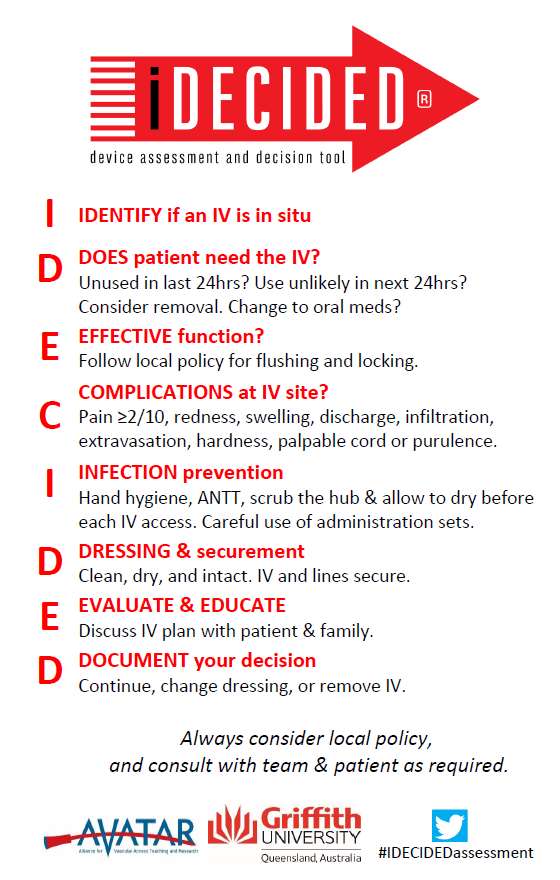I-DECIDED® Assessment and Decision Tool

Up to 70% of acute care hospital patients need a peripheral intravenous catheter (PIVC) for fluids or medicines.(1) Yet, up to 69% of PIVCs have painful complications or stop working before treatment is finished, requiring the insertion of a new device.(2) Device failure is painful for patients and time-consuming for staff, and can lead to increased morbidity, prolonged length of stay, and higher hospital costs.(2)
Regular, systematic assessment could help with prevention and early detection of complications.
I-DECIDED® is an evidence-based(3,4,5,6,7,8,9) assessment and decision tool for intravascular devices.(1)0 This simple checklist promotes comprehensive IV assessment and management, and prompts timely removal of IV devices.
Please, watch the video here: I-DECIDED® Assessment and Decision Tool
For further information, please contact
Dr Gillian Ray-Barruel
AVATAR, Griffith University
Queensland, Australia
g.ray-barruel@griffith.edu.au
References
1. Alexandrou E, Ray-Barruel G, Carr P, et al. Use of short peripheral intravenous catheters: characteristics, management, and outcomes worldwide. J Hosp Med. 2018;13(5).
2. Marsh N, Webster J, Larson E, et al. Observational study of peripheral intravenous catheter outcomes in adult hospitalized patients: A multivariable analysis of peripheral intravenous catheter failure. J Hosp Med. 2018;13(2):83-9.
3. HSE Health Protection Surveillance Centre. Prevention of intravascular catheter-related infection in Ireland. Update of 2009 national guidelines 2014b http://www.hpsc.ie/a-z/microbiologyantimicrobialresistance/infectioncontrolandhai/intravascularivlines/publications/File,4115,en.pdf
4. Loveday HP, Wilson JA, Pratt RJ, et al. epic3: National evidence-based guidelines for preventing healthcare-associated infections in NHS hospitals in England. J Hosp Infect. 2014;86, Supplement 1(0):S1-S70.
5. O'Grady NP, Alexander M, Burns LA, et al. Guidelines for the prevention of intravascular catheter-related infections. Clin Infect Dis. 2011;52(9):e162-93.
6. Queensland Health. PIVC guideline 2015 [https://www.health.qld.gov.au/publications/clinical-practice/guidelines-procedures/diseases-infection/governance/icare-pivc-guideline.pdf.
7. Royal College of Nursing. Standards for infusion therapy. London: RCN, 2016.
8. Infusion Nurses Society. Infusion therapy standards of practice. J Infus Nurs. 2016;39(1S):Suppl.
9. Seale H, Chughtai AA, Kaur R, et al. Ask, speak up, and be proactive: Empowering patient infection control to prevent health careacquired infections. Am J Infect Control. 2015;43(5):447-53.
10. Seale H, Chughtai AA, Kaur R, et al. Empowering patients in the hospital as a new approach to reducing the burden of health careassociated infections: The attitudes of hospital health care workers. Am J Infect Control. 2016;44(3):263-8.
11. Ray-Barruel G, Cooke M, Mitchell M, Chopra V, Rickard CM. Implementing the I-DECIDED clinical decision-making tool for peripheral intravenous catheter assessment and safe removal: protocol for an interrupted time-series study. BMJ Open. 2018;8.
) Author:Gillian Ray-Barruel
Author:Gillian Ray-Barruel| Tags:assessmentAVATARdressingsflushinginfection preventionintravenous catheterIV managementpatient experiencephlebitissecurementvascular access devices |








